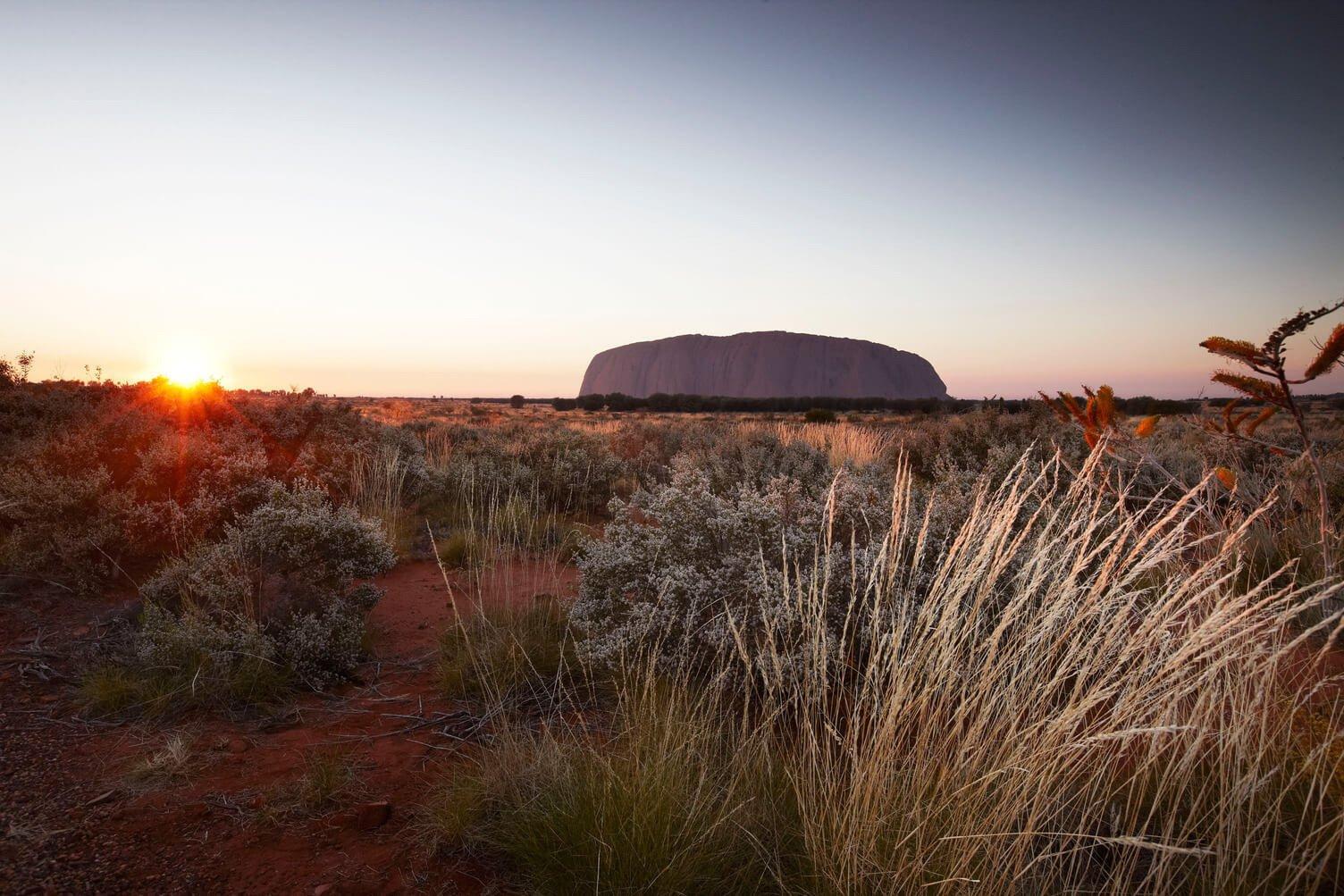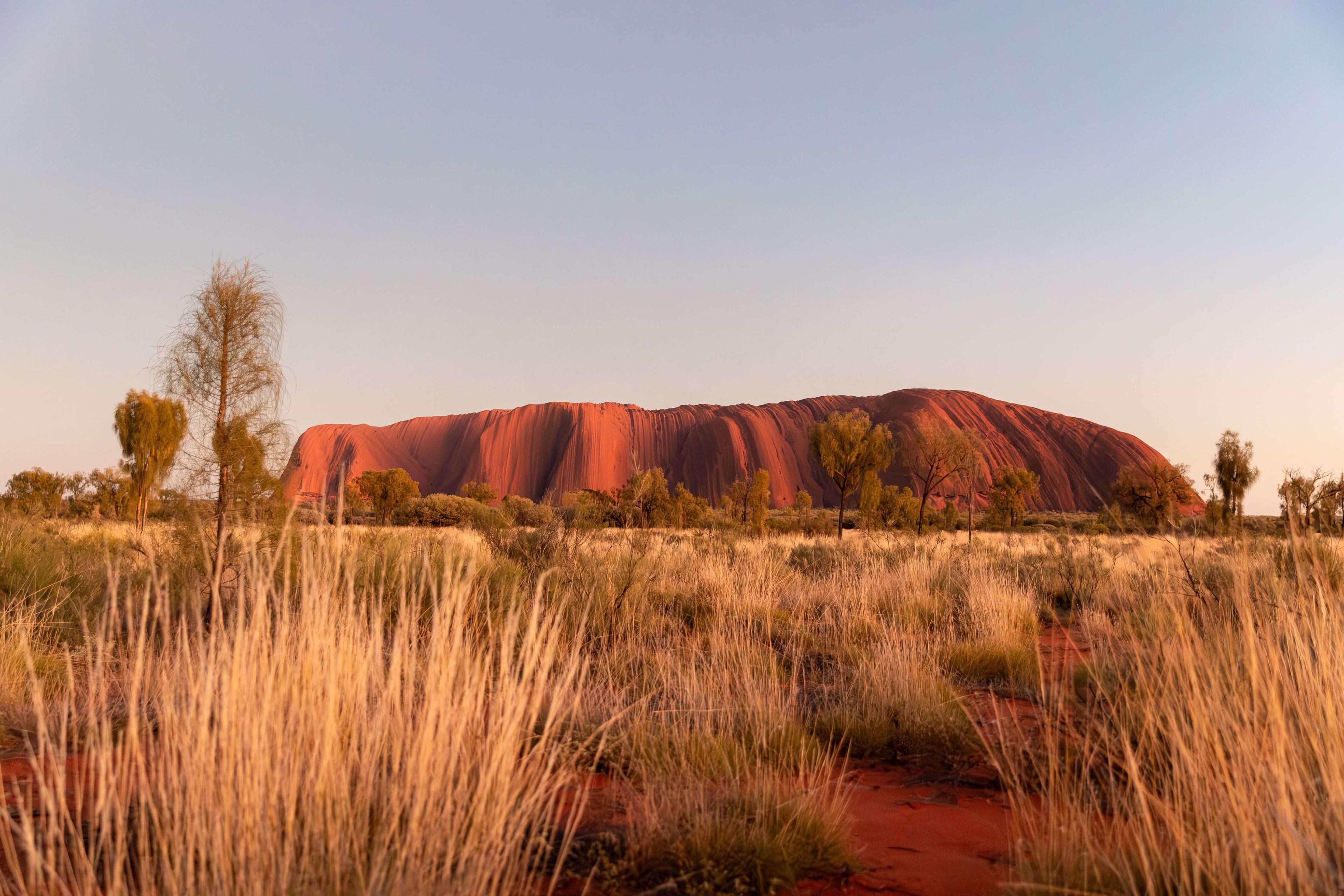The Importance of Uluru to Australian Indigenous Culture
One of Australia’s most widely recognised and revered landmarks, Uluru has a special significance among Indigenous Australians, in particular Anangu (pronounced arn-ung-oo), the Traditional Owners of the area.

One of Australia’s most widely recognised and revered landmarks, Uluru has a special significance among Indigenous Australians, in particular Anangu (pronounced arn-ung-oo), the Traditional Owners of the area. Listed as a UNESCO World Heritage Site, Uluru has been a popular tourist destination since the 1930s – but it’s been significant to Anangu culture for tens of thousands of years.


What is Uluru?
In geological terms, Uluru is an inselberg, or “island mountain”. It’s primarily composed of arkose, a coarse-grained sandstone rich in feldspar, and is sometimes referred to as a “monolith”, a term geologists dispute because it’s actually made up of multiple types of rock.
Its distinctive red hue is caused by oxidation or rust, just like the desert sands surrounding it. In fact, Uluru appears to change colour depending on the position of the sun – for the most brilliant display of fiery orange-red, check it out at sunrise or sunset.
It’s easy to spot Uluru from a distance, and you’ll get a great view as your plane descends at Ayers Rock Airport or as you drive across the desert and see it grow larger and larger ahead of you. Rising 348m above the desert plains, Uluru measures 3.6km long by 2.4km wide, with a 9.4km circumference. Much like an iceberg, the largest part of Uluru is below the surface – it extends at least 2.5km underground.
Uluru began to form about 550 million years ago, caused by a combination of huge tectonic forces, undersea compression, rainwater and erosion. This process took hundreds of millions of years – but for Anangu, Uluru has been there since the time of creation.
Traditional Cultural Significance of Uluru
Anangu are part of the world’s longest continuous living culture. Indigenous Australians have lived in Australia for at least 50,000 years - cultivating the land, trading and living in diverse and complex societies. To Anangu, Uluru is not a rock at all, but a living, breathing cultural landscape. Anangu believe that the local landscape, including Uluru and nearby Kata Tjuta, was created by ancestral beings. Anangu are devoted to preserving and protecting Uluru and its surrounds.
In Anangu culture, ancestral beings travelled throughout the desert and created Uluru and other nearby sites. The rocky outcrops, caves, and variations visible around the rock are evidence of the ancestors’ presence.
Tjukurpa
These creation stories form part of Tjukurpa (pronounced chook-er-pa) - stories that tell the creation of land and people, but also function as a map, with important lessons about the land and how to care for Country, survive in the desert, hunt, find food and water.
Tjukurpa is sometimes referred to as Dreamtime, however this term is not used in the area as Tjukurpa is no dream. Tjukurpa is a religious philosophy, a moral compass, a judicial system and a way of life that underpins everything Anangu do, now and in the future.
Tjukurpa is not written down. It is shared from person to person through oral storytelling, through art and also through Inma (songs and ceremonies).
Tjukurpa can be seen at Uluru as Tjukuritja - the physical evidence of the activities of Ancestral Beings that still exist in the land. When you walk around Uluru, you can see Tjukuritja in many locations.
There are more than 40 sacred Indigenous landmarks located around the base of Uluru - some that are appropriate to share with travellers and some that are sacred only to Anangu - each with its own special meaning and significance. Many of Uluru’s caves are adorned with ancient rock art, revealing creation stories and marking ceremonial sites that continue to play an important role in Anangu spiritual practices.
Contemporary Indigenous culture continues to thrive around Uluru, with Anangu actively involved in the management of the Uluru-Kata Tjuta National Park.


Historic Happenings at Uluru
It’s believed that the first non-Indigenous person to see Uluru was explorer William Gosse in 1873. In 1894, a team of scientists travelled to Uluru on a research expedition, examining the local area’s wildlife, geology, and culture. Over time, tourists began making the trek to visit Uluru and the surrounding areas in the late 1940s.
It wasn’t until the mid-50s that tourism really began to take off in the Red Centre. In 1958, what was previously known as Ayers Rock-Mount Olga National Park was created, encompassing both Uluru and Kata Tjuta. A new airstrip shortly followed, making it easier for visitors to access Uluru.
During the 1960s, Anangu lobbied the government for the right to own their Country, and in 1976 the Aboriginal Land Rights Act came into effect. This monumental act recognised Indigenous rights to the land and established guidelines for managing natural resources. In 1985, Australia’s Governor-General returned the title deeds to the National Park to Anangu in a deeply significant handback ceremony.
In 1987, Uluru-Kata Tjuta National Park was named a UNESCO World Heritage Site for its natural values. Seven years later, its designation as a living cultural landscape was also recognized by UNESCO. In 2000, the Summer Olympics were held in Sydney, and the Olympic Torch’s journey began with a lap around Uluru’s base.
Today, Anangu are extremely active and dedicated to preserving and maintaining Uluru and the surrounding areas as well as sharing them with visitors in respectful ways that honour their traditions and beliefs. UUluru and Kata Tjuta continue to be central to Anangu cultural activities.
Experiencing Uluru on Holiday
Visitors to Uluru are encouraged to engage in authentic experiences that are respectful of local culture. The traditional heartbeat of Anangu echoes through these interactions, offering a glimpse into a living, breathing heritage. Many visitors describe their time at Uluru as magical, spiritual, profound, and life-changing – there’s no doubt there’s something very special about this place.
Base walk: A must-do when you’re staying at Ayers Rock Resort! Walk the entire 9.4km loop around the base of Uluru, or explore shorter sections of the trail to observe sacred sites and points of interest. It is a flat walk with plenty of signage to indicate points of interest. Visitors are asked to keep to the marked paths and not walk off-track.
Wintjiri Wiru: A chapter of an ancestral Anangu story is brought to life with choreographed drones dancing above the silhouette of Uluru in the evening, with the wide open desert sky as the world’s greatest natural canvas. Before the show, enjoy light bites or a gourmet hamper featuring native and Indigenous flavours, paired with premium Australian wines and craft beers from Indigenous enterprise.
Desert Awakenings: Worth setting your alarm early for. This half-day tour will see you witness the sunrise illuminating the desert and lighting up Uluru from a spectacular and exclusive viewing platform, then savour hot drinks and fresh breakfast items to fuel your day. Once the sun is up, a guided tour around key points of interest at the base of Uluru introduces you to the area and its flora and fauna - particularly the trees and plants that provide sustenance for Anangu - while also providing a deeper understanding of Tjukurpa and creation stories.
Traditional Patji Tour: Located just outside the national park, Patji is a Traditional Family homeland. A seven-hour guided tour is an impactful and authentic way to hear from the Aboriginal community, including storytelling and sightseeing.
Additional Tours: Cruise around the base of Uluru on a segway. Soar overhead at sunset and see Uluru and Kata Tjuta at their boldest and brightest from above. There are plenty of ways to experience Uluru – make sure to add one (or more!) to your Outback itinerary.
Photo Ops: Throughout the resort, there are pathways that lead to viewing points of Uluru. Simply take an easy stroll on the marked track from your accommodation to the top of the dune and soak up the stunning vistas of Uluru at your leisure.


Discovering Uluru: Dos and Don’ts
To make the most of your Uluru visit while respecting the land and Anangu, here are some simple tips to keep in mind:
Demonstrate respect for land and people:
- Anyone may stroll around the base of Uluru - with or without a guide.
- Follow the guidelines and respect the cultural significance of the site.
- Adhere to signage and make sure to leave only footprints in national parks and throughout the resort.
Stay hydrated and protected:
- Pack a water bottle and drink more than you think you need.
- Layer up in lightweight clothing - it can be surprisingly cool in the desert during the winter months.
- Don’t forget a hat, sunscreen, and lip balm.
- Remember to wear close-toed shoes, and choose a pair you’re OK with taking on a bit of a reddish tint – you’re likely to track some of that red sand home with you!
Stay on designated paths:
- Stick to designated paths to preserve the delicate ecosystem and cultural sites.
- Climbing Uluru is not allowed out of respect for the indigenous beliefs and for safety reasons.
- Many visitors ask if they’re allowed to touch Uluru – the short answer is it depends and you should ask if unsure, but please never touch any of the rock art or paintings.
Adhere to photography restrictions:
- Some areas may have photography restrictions due to their cultural significance.
- Always ask for permission before taking photos and adhere to signage in sacred sites.


Start Planning Your Visit
Spending time at Uluru is not just a remarkable geological encounter, but a profound journey into the spiritual heart of Australia you won’t soon forget. You’re invited to explore Uluru and experience a centuries-old culture during your stay at Ayers Rock Resort. Participate in immersive activities, take your time discovering Uluru, and soak up the incredible natural beauty the Red Centre has on display 365 days a year.